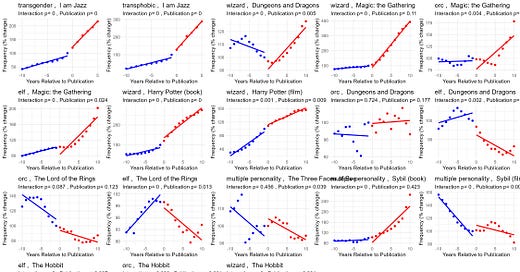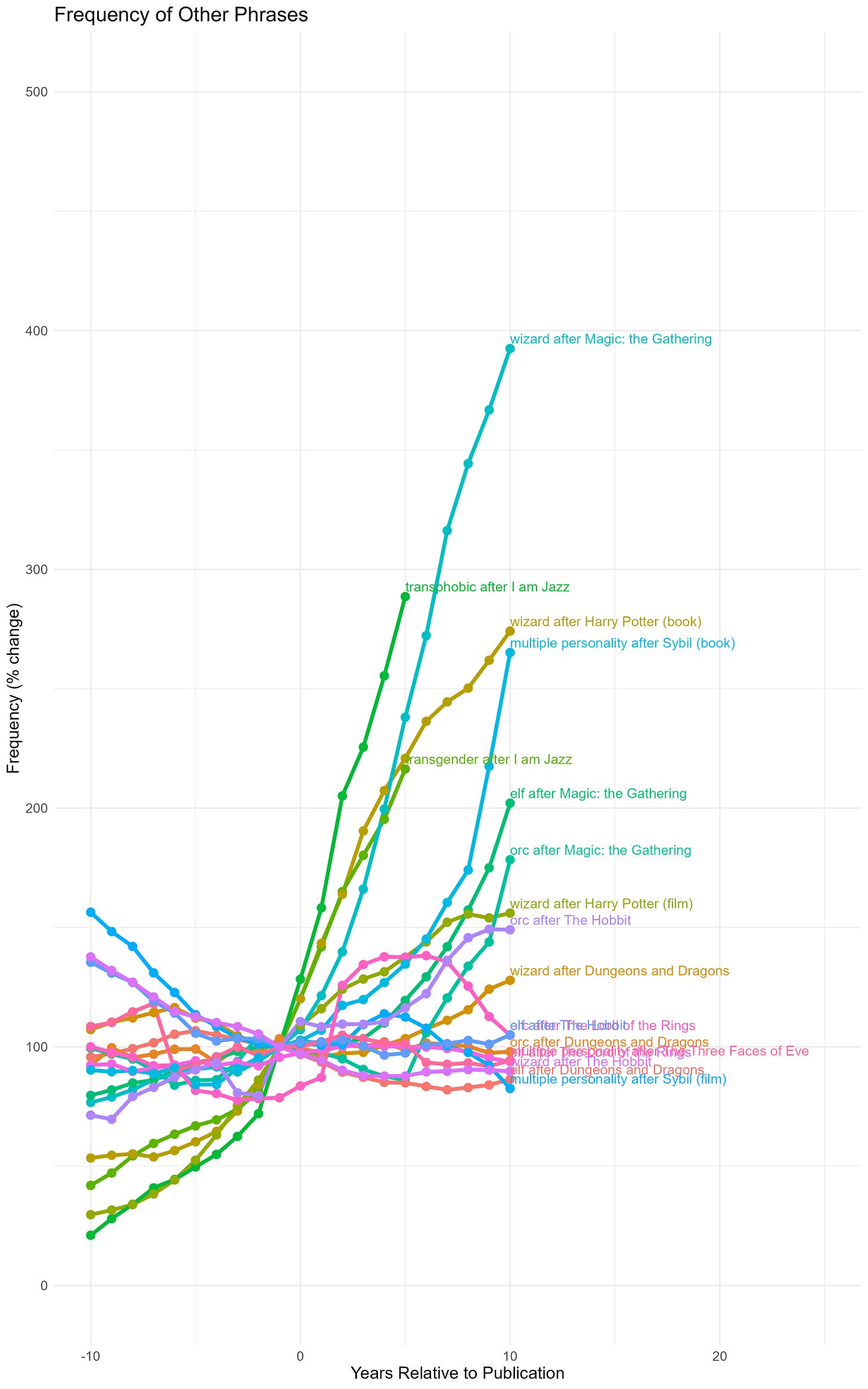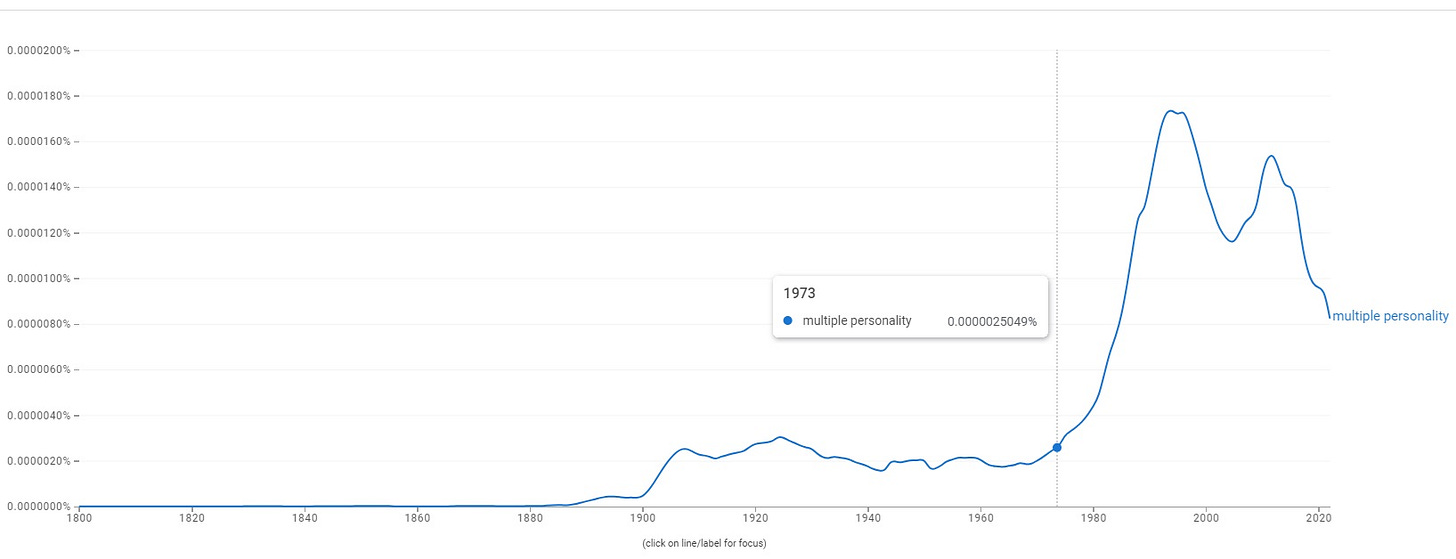I recently published a post about “word magic”, the phenomenon when a new idea penetrates public consciousness because of use in fiction. My idea was to show that how people think can be changed just by exposure to fiction, as a model of advertising and propaganda. Since my post I had some additional ideas about additional word magic candidates and people told me about even more. Here are some analyses of these.
Magical creatures
The late 20th century saw the birth of the fantasy genre. Orcs, wizards and elves are ubiquitous enough today that it’s worth checking out if we can find their origins in word magic. The prototypical fantasy book is of course The Lord of The Rings, published starting in 1954, but most of its fictional characters were already mentioned in The Hobbit, published in 1937. Other works with a possible word magic effect are the games Dungeons & Dragons (1974) and Magic: The Gathering (1993) and Harry Potter (book in 1997, movie adaptation in 2001).
I used the words “wizard”, “orc” and “elf” to track the entry of fantasy into the mainstream. Initially I wanted to use “dwarf” but I realized it has too many non-fantasy uses to be a good candidate.
Multiple personalities
Some people claim that they have ‘alters’, several parallel personalities living in the same body. It seems to be a fad among young people today with several TikTok channels dedicated to people claiming to have this condition. The DSM calls multiple personalities “dissociative identity disorder” (DID) and it can be formally diagnosed.
DID is a weird condition and it has not been widely known in the history of psychiatry. Its first description is probably in the patient Christine Beauchamp around 1900, who claimed to have three distinct personalities. Another famous book about the condition, The Three Faces of Eve, was published in 1957. During these decades, DID diagnoses were rare and the patients always had one or two alters at most.
The prototypical modern DID case was Sybil, a woman claiming to have 16 personalities because of child sexual abuse. A book was published about her in 1973 and this is the one that put the idea of a large number of personalities residing in the same person as a result of trauma in the mainstream. DID diagnoses since then have skyrocketed to hard-to-believe levels of >1% in some sources, making DID a good candidate for a sociogenic psychiatric disease.
I used the term “multiple personality” to track the effect of these works. “Dissociative identity disorder” as a term didn’t appear until the 1980s and simpler related terms like “dissociation”, “personalities” or “alters” have too many other meanings to be able to track this phenomenon.
Transgenderism
The rise in transgenderism in the 2010 is one of the most discussed word-magic related issues . The rate of transgender identification rose thousands to tens of thousands of percent over a few years (one British source about treatments). The print frequency of transgender-related words also rose by over 10k percent, a rise I compared to the appearance of hip-hop in the 1980s in its magnitude.
I am Jazz, a book about a boy claiming to be a girl, came out in 2014, with a movie adaptation in 2015. It obviously wasn’t the first work with a transgender character but “I am Jazz” was unique in that it was explicitly only about a transgender person, it was a reality show, not a drama or a tragedy, and it went very mainstream.
I used the words “transgender” and “transphobic” as trackers of the effect of “I am Jazz”.
The effects of these works
As before, I used the 2019 Google Ngram corpus, mined with a custom R script, to track the print publication frequency of my word of interest 10 years before and after the publication of key works. My model is always frequency ~ year * treatment: that is, I test if the publication of a work increased the frequency of a word (treatment main effect) and changed its trends (treatment interaction), while controlling for long-term trends (year main effect). One way to visualize the findings is this:
Some trends are nicer than others. There is little evidence that Tolkien’s classics changed interest in orcs, elves and wizards much. Although he obviously had a huge influence on modern fantasy, his effect only came later, showing one limitation of my methodology: it is possible to have very potent word magic with a lot of delay. Some trends I investigated before (such as vampires or hip-hop) were probably ready to blow up anyway from a vigorous subculture even if key works had not been published, but I don’t think anybody would have come up with fantasy if Tolkien hadn’t.
The original Dungeons and Dragons game had much less immediate impact than you would think for something so original. A very nice trend can be seen, however, for “Magic: The Gathering”. “Wizard” word frequencies blow up immediately with a little delay for “elf” and “orc”. The 1990s were huge in mainstreaming fantasy and “Magic: The Gathering” seems like a big vector for this. The Harry Potter books have a significant effect of interest in wizards, but they were riding on this wave rather than driving it. “I am Jazz” precedes a meteoric rise in transgender-related words, and Sybil (the book), but not the other DID-related works also affects word frequencies.
The other chart I showed before looks like this:
This is the relative change in Ngram word frequencies, compared to the year before publication, to the end of the 10-year monitoring period. (Only 5 years are available for “Jazz”). Most of my candidates this time are flops with no increase in word frequency at all. The best ones are followed by word frequency changes of 200-400%, which is weaker than what we saw before and in the magnitude of the weaker Great Awokening terms.
At this point, I think it’s fair to say that there are three kinds of word magic.
The first is the purest one and the one I was looking for in the first place. Here, a truly original concept which would otherwise remain unknown is popularized by a single work of fiction and blows up in the mainstream. “Bodybuilding” in my first post was probably the best example of this. Here, the closest one is multiple personalities, popularized by “Sybil”. The 10-year analysis window hides just how influential this piece of work was, here is the full Ngram word frequency chart:
Pretty much nobody used the term “multiple personality” until the Christine Beauchamp case around 1900. The use of the term flatlined pretty much right to the point Sybil was published in 1973. The 10-year rise after this book was much longer, word frequency still tripled from what I’m showing until its peak in the 1990s. Despite the TikTok trends, there is not much evidence though that interest is still increasing, it has been dropping for a good ten years. (It’s not because of the increased use of “dissociative identity disorder” either: that term has been dropping too.) Back in the 1973 Sybil pretty much by itself cemented the highly original idea of multiple personalities living in the same person’s body in the minds of many people, including psychiatrists who eventually included in the DSM-III in 1987.
The second kind of word magic is when the time trends look similar but the critical work is not truly original. Here, there is already is an idea ready to blow, there just happens to be one particular work based on it going mainstream for the first time. Hip-hop was like this – already a bustling subculture by the late 1970s when it went mainstream – and here the best example is “I am Jazz”. After a slow rise before, interest in transgenderism skyrockets after the publication of this book. Because of soaring diagnoses and political debates about transgenders, we also see a nice illustration that the change in Ngram word frequencies reflects real-world interest in phenomena. One problem is that it’s hard to pin all of this on “I am Jazz”, despite the nice time trends. Interest in transgenderism and other far-left agendas was well on the rise in 2014 already – even here we see a trend break already the year before publication, in 2013. I think “I am Jazz” was more of a product and a catalyst of a zeitgeist ready to blow anyway when it was published and if it had never came out, something else would have mainstreamed transgenderism. Bruce Jenner assuming his ‘Caitlyn’ identity in 2015 arguably had a similar effect.
The third kind of meme magic combines elements of the first and the second: the concept it popularizes is already fairly popular, but it’s not ready to blow until a new piece of work makes it popular. Vampires, time travel or extraterrestrials were like this in the first analysis: everybody well-read had known about these concepts for decades in the mid-20th century, it’s just that they didn’t think about them too much. It took an original piece of fiction like “The Day the Earth Stood Still” at the right time to make them popular. Here, fantasy terms are like this. Tolkien invented fantasy but his works did not have a big impact outside of a subculture until they became really popular in the 1990s. “Magic: The Gathering” is a reasonable candidate for the work that made fantasy mainstream.





